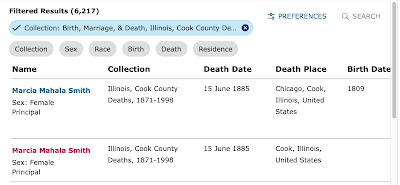Quick Introduction
Last Friday I visited the Chicago History Museum to explore the microfilmed Chicago Police Department Personnel Registers, 1890-1910, part of a collection titled Chicago Police Department collection [manuscript], 1966-1969.
There are three register volumes, 1890-1897, 1897-1904, and 1904-1910, and I chose to focus on the last one because it was the most relevant to my search. The names were grouped together by the first few letters of the surname and the handwritten entries were easy to read. It only took a couple of minutes to find the first match. I also took a quick look at an earlier volume and it wasn't quite as easy to use. The names were only grouped by first letter of surname and so I had to look through many more entries to find what I needed.
What Information Do the Registers Include?
Register entries cross two facing pages and the column headings are listed below.
(View large images: Page 1 Page 2)
(Number) There are numbers on the far left with no column heading and I'm not sure what they mean. Generally, they repeat, but when they change, they seem to climb sequentially.
Surname
Given Name
Star No. -- Usually not filled in.
Born (Month, Day, Year) -- Generally includes day, month, and year.
Place of Nativity -- Generally a country, a county and country, or a city and state.
Former Occupation -- Varied; examples include cigar maker, stone mason, railroad employee, piano maker, clerk, and cab driver.
Residence -- One or more street addresses.
Year -- Most likely the year the street address (above) was recorded.
Date of Appointment as Special -- Provides a date.
Date of Appointment on Probation -- Provides a date.
Date of Appointment as Regular -- Provides a date.
Resigned or Discharged -- Provides a date.; indicates resignation or discharge.
Cause -- This seems to be related to the resignation or discharge; causes are recorded with numerical codes.
Record (Fines) -- In one example, this column provides a date, the number of days of pay that were withheld, and the "Violation Rule No." In other example, the entry includes a date, the word "Susp'd," a Violation Rule No., and a note that the employee had been "restored to duty."
Record (Promotion) -- Provides date and rank and often includes multiple entries.
Retired on Pension -- Provides a date.
Many of the columns on the second page were blank, but the ones most relevant to family history research, were usually complete.
Why Search these Registers?
Birth information:
These registers provide birth dates and birth places that might otherwise be difficult to find. For example, many of the early Chicago records just list "Ireland" as place of birth, but these registers often include a county and in at least one case, the town and county in Ireland were listed.
Addresses:
Knowing where the family lived in a particular year can be a jumping off point for other research including city directories and church records.
Work history:
Knowing when a man joined and/or left the police force can be helpful in determining when individuals arrived in or left Chicago. It can also be helpful in narrowing down a death date. And, confirming a man's occupation before he joined the police force can be useful in tracking the family through earlier city directories or in confirming a matching record for a man with a common name.
Family stories:
Information about disciplinary action or promotions can add interesting detail to a family narrative.
And what about the scrapbook?
I also took a look at the scrapbook covering 1912-1914. It would be interesting to read and it might be helpful to someone looking for a particular event within that time period if an exact date was unknown. If the date was known, it would be better to search newspapers directly so the title, publication date, and page number could be recorded.
Tips for Making a Research Trip to the Chicago History Museum
The Museum's website offers useful tips, so I'll just mention a couple of things. First, take a USB flash drive in case you want to save images from microfilm. And second take a camera. Scanners aren't permitted, but cameras are. I used my cell phone. It worked great.
And, in case you're wondering how to get there, I took the #22 bus from the Daley Center because I visited the Circuit Court Archives on my way and it was very easy. You can drive--there's a parking lot quite close--but there are also many possibilities for bus and "L" listed on the Museum's directions page.









